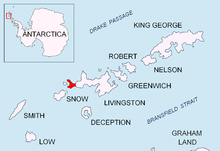Robbery Beaches


Robbery Beaches are beaches extending along the north side of Byers Peninsula, Livingston Island in the South Shetland Islands, Antarctica between Essex Point to the west and Nedelya Point to the east.
The name ‘Robbery Beach’ was used by James Weddell in 1820-23. It arose from the English robbery of sealskins collected by the American brig Charity (Capt. Charles H. Barnard) of New York in January 1821. There was fierce competition between British and American sealers in the area during the early 1820s.
Location
The beaches are centred at 62°36′57.6″S 61°04′58.8″W / 62.616000°S 61.083000°W (British mapping in 1968, detailed Spanish mapping in 1992, and Bulgarian mapping in 2005 and 2009).
Maps
- Península Byers, Isla Livingston. Mapa topográfico a escala 1:25000. Madrid: Servicio Geográfico del Ejército, 1992.
- L.L. Ivanov et al. Antarctica: Livingston Island and Greenwich Island, South Shetland Islands. Scale 1:100000 topographic map. Sofia: Antarctic Place-names Commission of Bulgaria, 2005.
- L.L. Ivanov. Antarctica: Livingston Island and Greenwich, Robert, Snow and Smith Islands. Scale 1:120000 topographic map. Troyan: Manfred Wörner Foundation, 2009. ISBN 978-954-92032-6-4
- Antarctic Digital Database (ADD). Scale 1:250000 topographic map of Antarctica. Scientific Committee on Antarctic Research (SCAR). Since 1993, regularly upgraded and updated.
- L.L. Ivanov. Antarctica: Livingston Island and Smith Island. Scale 1:100000 topographic map. Manfred Wörner Foundation, 2017. ISBN 978-619-90008-3-0
References
![]() This article incorporates public domain material from "Robbery Beaches". Geographic Names Information System. United States Geological Survey.
This article incorporates public domain material from "Robbery Beaches". Geographic Names Information System. United States Geological Survey.
